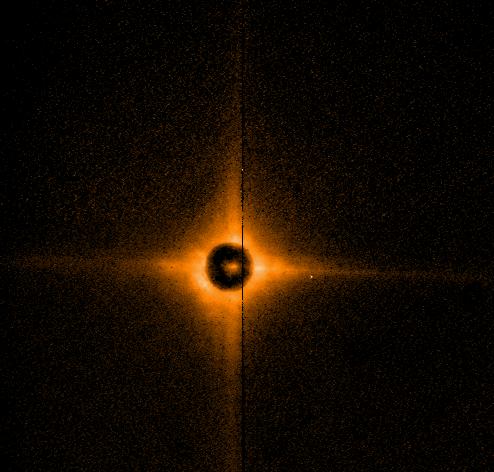

 Image of a star behind the 2" mask. |
OSCA - coronography at the WHT OSCA (Optimised Stellar Coronograph for Adaptive Optics) is the coronographic mask device to be used in combination with NAOMI and INGRID for infrared coronography. It was installed and commissioned in May and August 2002 and is offered to the community from 2003A on. It was built at the Optical Science Laboratory of the University College London (UCL) by Peter Doel (PI). Click here to go to the UCL webpage of OSCA OSCA effectively suppresses light of a bright object and therefore enables the detection of faint structures or objects close to the host object which are otherwise overshined. OSCA is mounted permanently after the AO system NAOMI at the WHT and can be deployed within a few seconds into the beam making the system very flexible during nighttime. Nevertheless potential observers are asked to inform ING staff well before their run if they are going to use OSCA as it requires some preparation of the AO system to be fully optimized for the use of the coronograph. Please consult the page about preparation of observations before writing a proposal or send any questions to sels@ing.iac.es. Currently six different mask sizes with hard edges are permanently mounted inside OSCA: 0"2, 0"65, 0"8, 1"0, 1"6 and 2"0. Two gaussian shaped masks with fwhm=0"5 and 0"6 optimized for the optical wavelength domain are also available. All masks can be selected remotely. At present OSCA can only be used in combination with INGRID for near infrared (J, H, Ks) imaging observations but it is also intended to be used with the integral field spectrograph OASIS coming in 2003. |
 |
Last Updated: 19.06.03 S. Els sels@ing.iac.es |